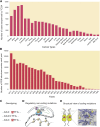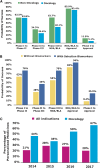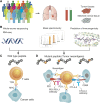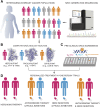Personal Mutanomes Meet Modern Oncology Drug Discovery and Precision Health
- PMID: 30545954
- PMCID: PMC6294046
- DOI: 10.1124/pr.118.016253
Personal Mutanomes Meet Modern Oncology Drug Discovery and Precision Health
Abstract
Recent remarkable advances in genome sequencing have enabled detailed maps of identified and interpreted genomic variation, dubbed "mutanomes." The availability of thousands of exome/genome sequencing data has prompted the emergence of new challenges in the identification of novel druggable targets and therapeutic strategies. Typically, mutanomes are viewed as one- or two-dimensional. The three-dimensional protein structural view of personal mutanomes sheds light on the functional consequences of clinically actionable mutations revealed in tumor diagnosis and followed up in personalized treatments, in a mutanome-informed manner. In this review, we describe the protein structural landscape of personal mutanomes and provide expert opinions on rational strategies for more streamlined oncological drug discovery and molecularly targeted therapies for each individual and each tumor. We provide the structural mechanism of orthosteric versus allosteric drugs at the atom-level via targeting specific somatic alterations for combating drug resistance and the "undruggable" challenges in solid and hematologic neoplasias. We discuss computational biophysics strategies for innovative mutanome-informed cancer immunotherapies and combination immunotherapies. Finally, we highlight a personal mutanome infrastructure for the emerging development of personalized cancer medicine using a breast cancer case study.
U.S. Government work not protected by U.S. copyright.
Figures






References
-
- Albert FW, Kruglyak L. (2015) The role of regulatory variation in complex traits and disease. Nat Rev Genet 16:197–212. - PubMed
-
- Balachandran VP, Łuksza M, Zhao JN, Makarov V, Moral JA, Remark R, Herbst B, Askan G, Bhanot U, Senbabaoglu Y, et al. Australian Pancreatic Cancer Genome Initiative; Garvan Institute of Medical Research; Prince of Wales Hospital; Royal North Shore Hospital; University of Glasgow; St Vincent’s Hospital; QIMR Berghofer Medical Research Institute; University of Melbourne, Centre for Cancer Research; University of Queensland, Institute for Molecular Bioscience; Bankstown Hospital; Liverpool Hospital; Royal Prince Alfred Hospital, Chris O’Brien Lifehouse; Westmead Hospital; Fremantle Hospital; St John of God Healthcare; Royal Adelaide Hospital; Flinders Medical Centre; Envoi Pathology; Princess Alexandria Hospital; Austin Hospital; Johns Hopkins Medical Institutes; ARC-Net Centre for Applied Research on Cancer (2017) Identification of unique neoantigen qualities in long-term survivors of pancreatic cancer. Nature 551:512–516. - PMC - PubMed

